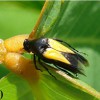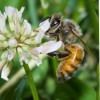 These caterpillars roll up leaves of the host plants and use the rolled leaves as larval retreats and locations for pupal cocoons. Although these leaf-eating pests do no permanent damage, they can completely defoliate fiddlewood, a Florida native that can form a large shrub or small tree. The shrub simply puts out a new flush of leaves. The larvae themselves are valuable food source for baby birds during the spring dry season in Florida. This 4-page fact sheet was written by William H. Kern, and published by the UF Department of Entomology and Nematology, February 2015. (Photo:W.H. Kern, Jr., UF/IFAS/FLREC)
These caterpillars roll up leaves of the host plants and use the rolled leaves as larval retreats and locations for pupal cocoons. Although these leaf-eating pests do no permanent damage, they can completely defoliate fiddlewood, a Florida native that can form a large shrub or small tree. The shrub simply puts out a new flush of leaves. The larvae themselves are valuable food source for baby birds during the spring dry season in Florida. This 4-page fact sheet was written by William H. Kern, and published by the UF Department of Entomology and Nematology, February 2015. (Photo:W.H. Kern, Jr., UF/IFAS/FLREC)
http://edis.ifas.ufl.edu/in1079
Tag: W. Kern
Wedge-Shaped Beetles (suggested common name) Ripiphorus spp. (Insecta: Coleoptera: Ripiphoridae)
 Ripiphoridae are a family of unusual parasitic beetles that are thought to be related to tumbling flower beetles and blister beetles. They parasitize bees and wasps, roaches, and wood-boring beetles, but specific hosts for many ripiphorid species are unknown. Their secretive life cycle makes an assessment of their economic and ecological impact very difficult. Additional research is necessary to determine the abundance and impact of Ripiphorus species. This 4-page fact sheet was written by David Owens, Ashley N. Mortensen, Jeanette Klopchin, William Kern, and Jamie D. Ellis, and published by the UF Department of Entomology and Nematology, December 2014.
Ripiphoridae are a family of unusual parasitic beetles that are thought to be related to tumbling flower beetles and blister beetles. They parasitize bees and wasps, roaches, and wood-boring beetles, but specific hosts for many ripiphorid species are unknown. Their secretive life cycle makes an assessment of their economic and ecological impact very difficult. Additional research is necessary to determine the abundance and impact of Ripiphorus species. This 4-page fact sheet was written by David Owens, Ashley N. Mortensen, Jeanette Klopchin, William Kern, and Jamie D. Ellis, and published by the UF Department of Entomology and Nematology, December 2014.
http://edis.ifas.ufl.edu/in1069
Minimizing Honey Bee Exposure to Pesticides
 Protecting honey bees and other pollinators from pesticide impacts is important to the sustainability of agriculture. Consequently, pesticide applicators must determine if there is a clear hazard to managed or wild populations of bees. Potential exposure of bees to pesticides can vary greatly depending on the type of pesticide, formulation, application method, label restrictions, and other factors. The goal in using a pesticide is to achieve maximum benefit (success) with minimum negative impact, and these factors should always be considered in pesticide selection. This publication is written (1) to help assure the sustainability of both bees and agriculture by informing beekeepers, pesticide users, and the general public about the often complex relationship between pollinators (specifically bees) and pesticides, (2) to offer guidance for improved communication between beekeepers and pesticide users, (3) to offer pollinator risk-reducing strategies for growers and other applicators when using pesticides, and (4) to provide clarity in laws, labeling, and associated definitions. This 14-page fact sheet was written by J. D. Ellis, J. Klopchin, E. Buss, F. M. Fishel, W. H. Kern, C. Mannion, E. McAvoy, L. S. Osborne, M. Rogers, M. Sanford, H. Smith, P. Stansly, L. Stelinski, and S. Webb, and published by the UF Department of Entomology and Nematology, March 2014.
Protecting honey bees and other pollinators from pesticide impacts is important to the sustainability of agriculture. Consequently, pesticide applicators must determine if there is a clear hazard to managed or wild populations of bees. Potential exposure of bees to pesticides can vary greatly depending on the type of pesticide, formulation, application method, label restrictions, and other factors. The goal in using a pesticide is to achieve maximum benefit (success) with minimum negative impact, and these factors should always be considered in pesticide selection. This publication is written (1) to help assure the sustainability of both bees and agriculture by informing beekeepers, pesticide users, and the general public about the often complex relationship between pollinators (specifically bees) and pesticides, (2) to offer guidance for improved communication between beekeepers and pesticide users, (3) to offer pollinator risk-reducing strategies for growers and other applicators when using pesticides, and (4) to provide clarity in laws, labeling, and associated definitions. This 14-page fact sheet was written by J. D. Ellis, J. Klopchin, E. Buss, F. M. Fishel, W. H. Kern, C. Mannion, E. McAvoy, L. S. Osborne, M. Rogers, M. Sanford, H. Smith, P. Stansly, L. Stelinski, and S. Webb, and published by the UF Department of Entomology and Nematology, March 2014.
http://edis.ifas.ufl.edu/in1027
Florida Master Beekeeper Program Requirements
 The Master Beekeeper Program (MBP) is a five-year (minimum) beekeeper training and certification program provided by the University of Florida. One must already be a beekeeper to enter the program. This 22-page fact sheet was written by James Ellis, Jerry Hayes, Catherine Zettel Nalen, William H. Kern, Ray Zerba, Brad Burbaugh, and Jeanette Klopchin, and published by the UF Department of Entomology and Nematology, October 2013.
The Master Beekeeper Program (MBP) is a five-year (minimum) beekeeper training and certification program provided by the University of Florida. One must already be a beekeeper to enter the program. This 22-page fact sheet was written by James Ellis, Jerry Hayes, Catherine Zettel Nalen, William H. Kern, Ray Zerba, Brad Burbaugh, and Jeanette Klopchin, and published by the UF Department of Entomology and Nematology, October 2013.
http://edis.ifas.ufl.edu/in847
Preserving Woodenware in Beekeeping Operations (ENY125/AA244)
 The predominant material used to construct honey bee colonies in the U.S. is wood. Though honey bee hive components are simple in design, they are subjected to many extreme management techniques that cause wear and tear, ultimately shortening the life of the equipment. This article discusses how to protect colony woodenware, particularly the pieces that are exposed to the elements. These include the bottom board, hive body/supers, and lids. This 4-page fact sheet was written by J. D. Ellis, W. H. Kern, and C. M. Zettel Nalen, and published by the UF Department of Entomology and Nematology, June 2012.
The predominant material used to construct honey bee colonies in the U.S. is wood. Though honey bee hive components are simple in design, they are subjected to many extreme management techniques that cause wear and tear, ultimately shortening the life of the equipment. This article discusses how to protect colony woodenware, particularly the pieces that are exposed to the elements. These include the bottom board, hive body/supers, and lids. This 4-page fact sheet was written by J. D. Ellis, W. H. Kern, and C. M. Zettel Nalen, and published by the UF Department of Entomology and Nematology, June 2012.
http://edis.ifas.ufl.edu/aa244
Northern Racoon (WEC34/UW033)
Raccoons are found statewide in Florida in ever-increasing numbers. Urbanization and agriculture often help their population because food becomes more available in these conditions. Therefore, it is not at all uncommon to encounter raccoons near your home or neighborhood. Learn more facts about raccoon biology and how to (legally) solve raccoon problems. This 7-page fact sheet was written by William H. Kern Jr., and published by the UF Department of Wildlife Ecology and Conservation, January 2012. http://edis.ifas.ufl.edu/uw033
Giant Whip Scorpion Mastigoproctus giganteus giganteus (Lucas, 1835) (Arachnida: Thelyphonida (=Uropygi): Thelyphonidae) (EENY493/IN890)
To encounter a giant whip scorpion for the first time can be an alarming experience! What seems like a miniature monster from a horror movie is really a fairly benign creature. While called a scorpion, this arachnid has neither the venom-filled stinger found in scorpions nor the venomous bite found in some spiders. This 4-page fact sheet was written by W.H. Kern Jr. and R.E. Mitchell, and published by the UF Department of Entomology and Nematology, May 2011.
http://edis.ifas.ufl.edu/in890
ENY-211/IG098 Drywood and Dampwood Termites
Revised! ENY-211, a 6-page illustrated fact sheet by F. M. Oi, R. Scheffrahn, W. Kern, and K. C. Ruppert, describes these two groups of structurally damaging termites that live inside the wood they eat, signs of infestation, and control. Published by the UF Department of Entomology and Nematology, June 2008.
http://edis.ifas.ufl.edu/IG098